Optimizing Grouting Parameters to Control Ground Deformation in the Shield Tunneling
Abstract
1. Introduction
2. Shield Tunneling Conditions
3. Controlling the Shield Grouting Parameters
3.1. Synchronous Grouting Pressure Control of Shield
- Due to the presence of the mud cake, the infiltration between the slurry and the soil at the tunnel face can be ignored, and only the pressure-density effect of the slurry on the soil during the grouting process was considered.
- Assuming that the grout body is hemispherical in the soil, the compression grouting process is equivalent to the expansion of a hemispherical hole with a radius Ru in a semi-infinite soil body (Figure 4a), creating a stress-affected zone around the spherical hole. This stress-affected zone consists of a plastic zone and an elastic zone (Figure 4b).
- The slurry and soil particles are incompressible and the effect of gravity on soil compression was not considered.
3.2. Relationship between Shield Grouting Pressure and Grouting Volume
4. Case Studies
5. Conclusions
- (1)
- The equation for calculating the synchronous grouting pressure was proposed considering the variation of the surface structure load. Results from the case study suggest that by appropriately adjusting the grouting pressure based on the overlying ground/surface load, the ground settlement can be well controlled and the impact of shield tunneling on the surrounding environment can be reduced.
- (2)
- Although the amount of synchronous grouting is related to parameters such as soil conditions, slurry viscosity, shield tail and slurry permeability coefficient, the primary factor affecting the grout amount for a given construction section is the grouting pressure. Based on the linear relationship between the grout amount and grouting pressure, the method that can accurately predict the required grout amount in the subsequent construction section was proposed.
- (3)
- When the shield tunnel is beneath the surface building, grouting pressure should be increased to compensate the additional load from the building. If the grouting pressure is insufficient, the secondary grouting should be carried out in time. Results in the Jurong metro shield tunnel show that by maintaining the secondary grouting pressure as 0.4–0.6 MPa for more than half an hour, the uneven settlement of the building caused by the shield construction was effectively controlled.
Author Contributions
Funding
Data Availability Statement
Conflicts of Interest
Correction Statement
References
- Xu, J.M.; Franza, A.; Marshall, A.M. Tunnel-framed building interaction: Comparison between raft and separate footing foundations. Géotechnique 2021, 71, 631–644. [Google Scholar] [CrossRef]
- Xu, J.M.; Franza, A.; Marshall, A.M. Response of Framed Buildings on Raft Foundations to Tunneling. J. Geotech. Geoenvironmental Eng. 2020, 146, 04020120. [Google Scholar] [CrossRef]
- Xie, X.; Wang, Q.; Shahrour, I.; Li, J.; Zhou, B. A real-time interaction platform for settlement control during shield tunnelling construction. Autom. Constr. 2018, 94, 154–167. [Google Scholar] [CrossRef]
- Jiang, X.; Zhu, H.; Yan, Z.; Zhang, F.; Huang, X.; Leng, Z.; Xiao, R. Fire-retarding asphalt pavement for urban road tunnels: A state-of-the-art review and beyond. In Fire Technology; Springer: Berlin/Heidelberg, Germany, 2024; pp. 1–41. [Google Scholar]
- Yu, C.; Zhou, A.; Chen, J.; Arulrajah, A.; Horpibulsuk, S. Analysis of a tunnel failure caused by leakage of the shield tail seal system. Undergr. Space 2020, 5, 105–114. [Google Scholar] [CrossRef]
- Jiang, X.; Zhang, X.; Zhang, X.; Long, L.; Bai, Y.; Huang, B. Advancing Shallow Tunnel Construction in Soft Ground: The Pipe-Umbrella Box Jacking Method. Transp. Res. Rec. 2024, 03611981231225430. [Google Scholar] [CrossRef]
- Li, P.; Dai, Z.; Huang, D.; Cai, W.; Fang, T. Impact analysis for safety prevention and control of special-shaped shield construction closely crossing multiple operational metro tunnels in shallow overburden. Geotech. Geol. Eng. 2021, 40, 2127–2144. [Google Scholar] [CrossRef]
- Zheng, D.; Bezuijen, A.; Thewes, M. An experimental study on foam infiltration into saturated sand and its consequence for EPB shield tunneling. Tunn. Undergr. Space Technol. 2021, 111, 103878. [Google Scholar] [CrossRef]
- Shi, F. Settlement Deformation Analysis and Protection Technology Research of Existing Structures under the Subway Shield Tunneling; Lanzhou University: Lanzhou, China, 2020. (In Chinese) [Google Scholar]
- Liu, Y.Z. Study on the Influence of Subway Shield Tunneling on the Settlement of Existing Buildings; Dalian Maritime University: Dalian, China, 2019. (In Chinese) [Google Scholar]
- Liao, S.M.; Liu, J.H.; Wang, R.L.; Li, Z.M. Shield tunneling and environment protection in Shanghai soft ground. Tunn. Undergr. Space Technol. 2009, 24, 454–465. [Google Scholar] [CrossRef]
- Ye, F.; Qin, N.; Han, X.; Liang, X.; Gao, X.; Ying, K. Displacement infiltration diffusion model of power-law grout as backfill grouting of a shield tunnel. Eur. J. Environ. Civ. Eng. 2022, 26, 1820–1833. [Google Scholar] [CrossRef]
- Li, C. Simplified algorithm for grouting pressure and grouting quantity in shield construction. Int. J. Civ. Eng. 2020, 18, 419–428. [Google Scholar] [CrossRef]
- Jiang, X.; Zhu, H.; Yan, Z.; Zhang, F.; Ye, F.; Li, P.; Huang, B. A state-of-art review on development and progress of backfill grouting materials for shield tunneling. Dev. Built Environ. 2023, 16, 100250. [Google Scholar] [CrossRef]
- Gou, C. Research on Grout Diffusion Mechanism behind the Shield Tunnel Wall; Chang’an University: Xi’an, China, 2013; (In Chinese). [Google Scholar] [CrossRef]
- Xu, J.; Zheng, L.; Song, G.; Zhang, D.; Sheil, B.; Marshall, A. Effects of embedded walls on tunnelling-induced sandy ground displacements: A numerical investigation. Géotechnique, 2024; in press. [Google Scholar] [CrossRef]
- Xu, J.; Gui, J.; Sheil, B. A numerical investigation of the role of basements on tunnel-frame interaction in sandy soil. Comput. Geotech. 2024, 169, 106197. [Google Scholar] [CrossRef]
- Xie, X.Y.; Zhai, J.L.; Biao, Z. Back-fill grouting quality evaluation of the shield tunnel using ground penetrating radar with bi-frequency back projection method. Autom. Constr. 2021, 121, 103435. [Google Scholar] [CrossRef]
- Liu, X.X.; Shen, S.L.; Zhou, A.; Xu, Y.S. Evaluation of foam conditioning effect on groundwater inflow at tunnel cutting face. Int. J. Numer. Anal. Methods Geomech. 2019, 43, 463–481. [Google Scholar] [CrossRef]
- Fang, Y.; He, C.; Nazem, A.; Yao, Z.; Grasmick, J. Surface settlement prediction for EPB shield tunneling in sandy ground. KSCE J. Civ. Eng. 2017, 21, 2908–2918. [Google Scholar] [CrossRef]
- Hai, L.; Xie, X.Y.; Sato, M. Accurate thickness estimation of a backfill grouting layer behind shield tunnel lining by CMP measurement using GPR. In Proceedings of the 14th International Conference on Ground Penetrating Radar, Shanghai, China, 4–8 June 2012; pp. 137–142. [Google Scholar] [CrossRef]
- Sun, Y.; Liu, D.; Wang, G. Experimental Study on the Effects of New Foam on the Improvement of Sandy Soil for Earth Pressure Balance Shield. Buildings 2023, 13, 682. [Google Scholar] [CrossRef]
- Li, J.K.; Hou, Q.H.; Liang, W.J. Analysis of Dalian Subway Tunnel Shield Construction Impact with Engineering Materials and Engineering Mechanics on Existing Bridge Pier. Adv. Mater. Res. 2014, 848, 96–99. [Google Scholar] [CrossRef]
- Li, Z.P.; Li, S.C.; Liu, H.J. Experimental Study on the Reinforcement Mechanism of Segmented Split Grouting in a Soft Filling Medium. Processes 2018, 6, 131. [Google Scholar] [CrossRef]
- Rafi, J.Y.; Stille, H. Basic mechanism of elastic jacking and impact of fracture aperture change on grout spread, transmissivity and penetrability. Tunn. Undergr. Space Technol. 2015, 49, 174–187. [Google Scholar] [CrossRef]
- Zhang, N.; Shen, S.L.; Zhou, A.N.; Lyu, H.M. Challenges of earth pressure balance tunnelling in weathered granite with boulders. Proc. Inst. Civ. Eng.-Geotech. Eng. 2021, 174, 372–389. [Google Scholar] [CrossRef]
- Ye, F.; Yang, T.; Mao, J.H. Half-spherical surface diffusion model of shield tunnel back-fill grouting based on infiltration effect. Tunn. Undergr. Space Technol. 2019, 83, 274–281. [Google Scholar] [CrossRef]
- Bezuijen, A.; Talmon, A.M.; Kaalberg, F.J. Field measurements of grout pressures during tunnelling of the sophia rail tunnel. J. Jpn. Geotech. Soc. 2008, 44, 39–48. [Google Scholar] [CrossRef]
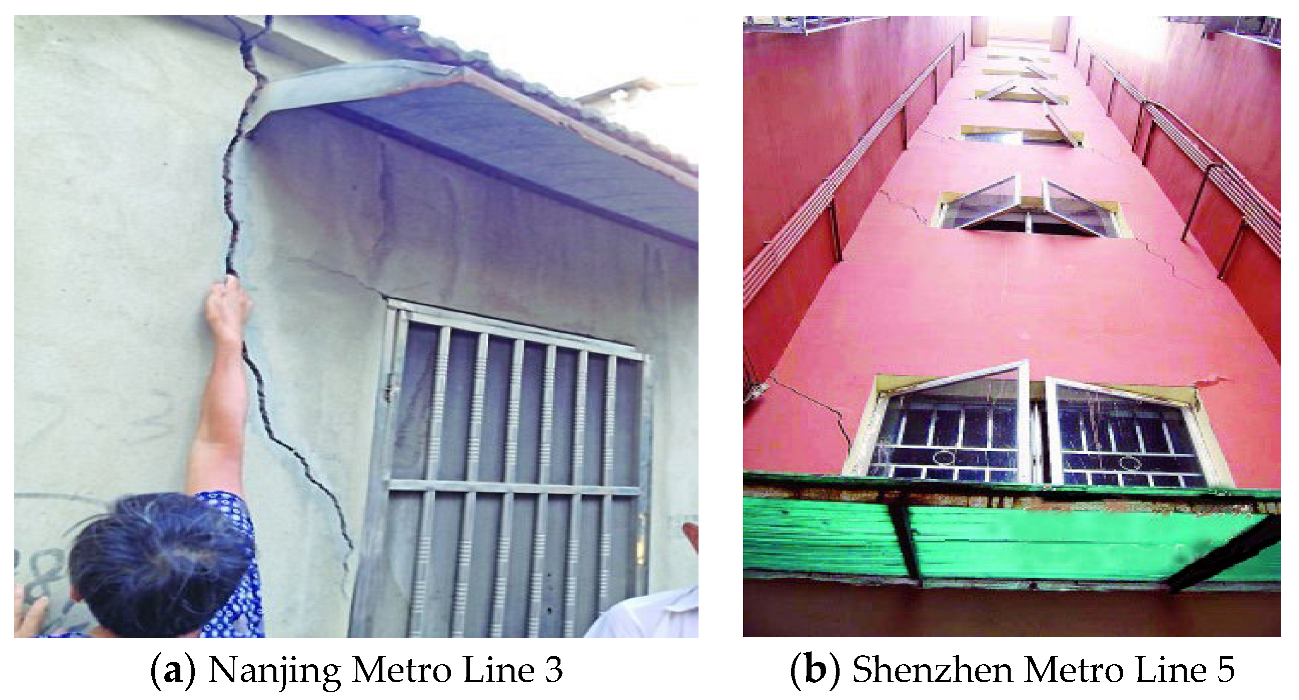
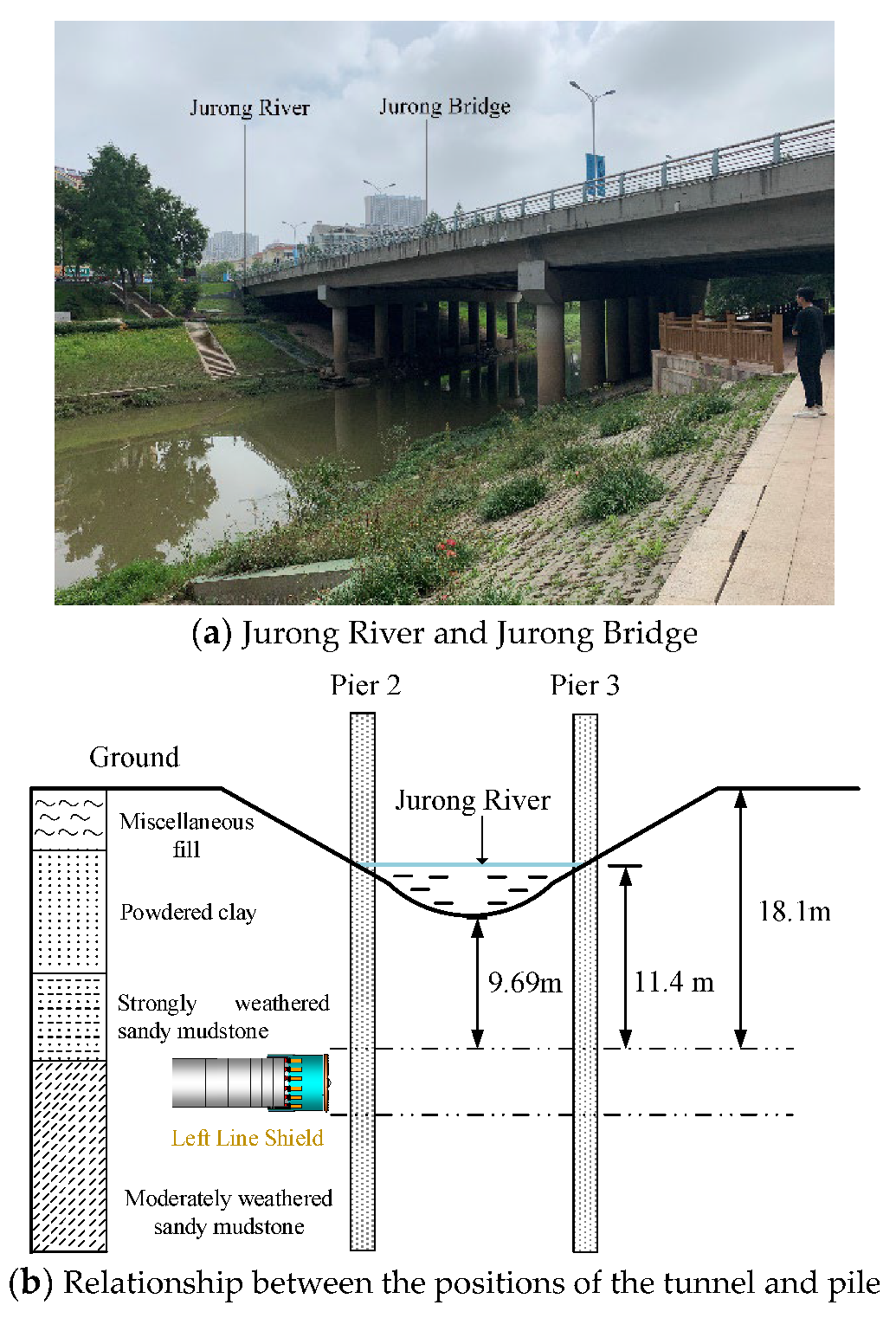
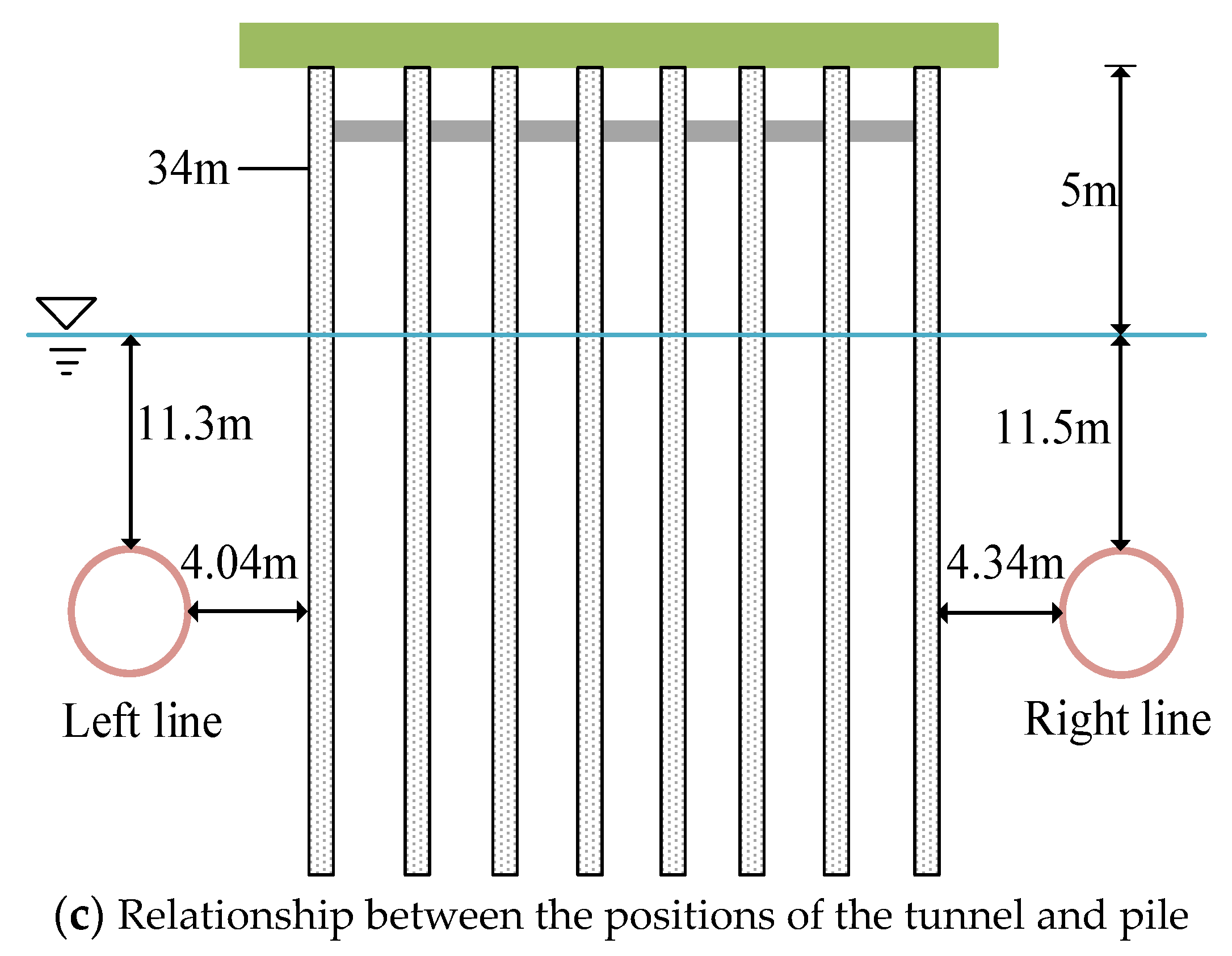
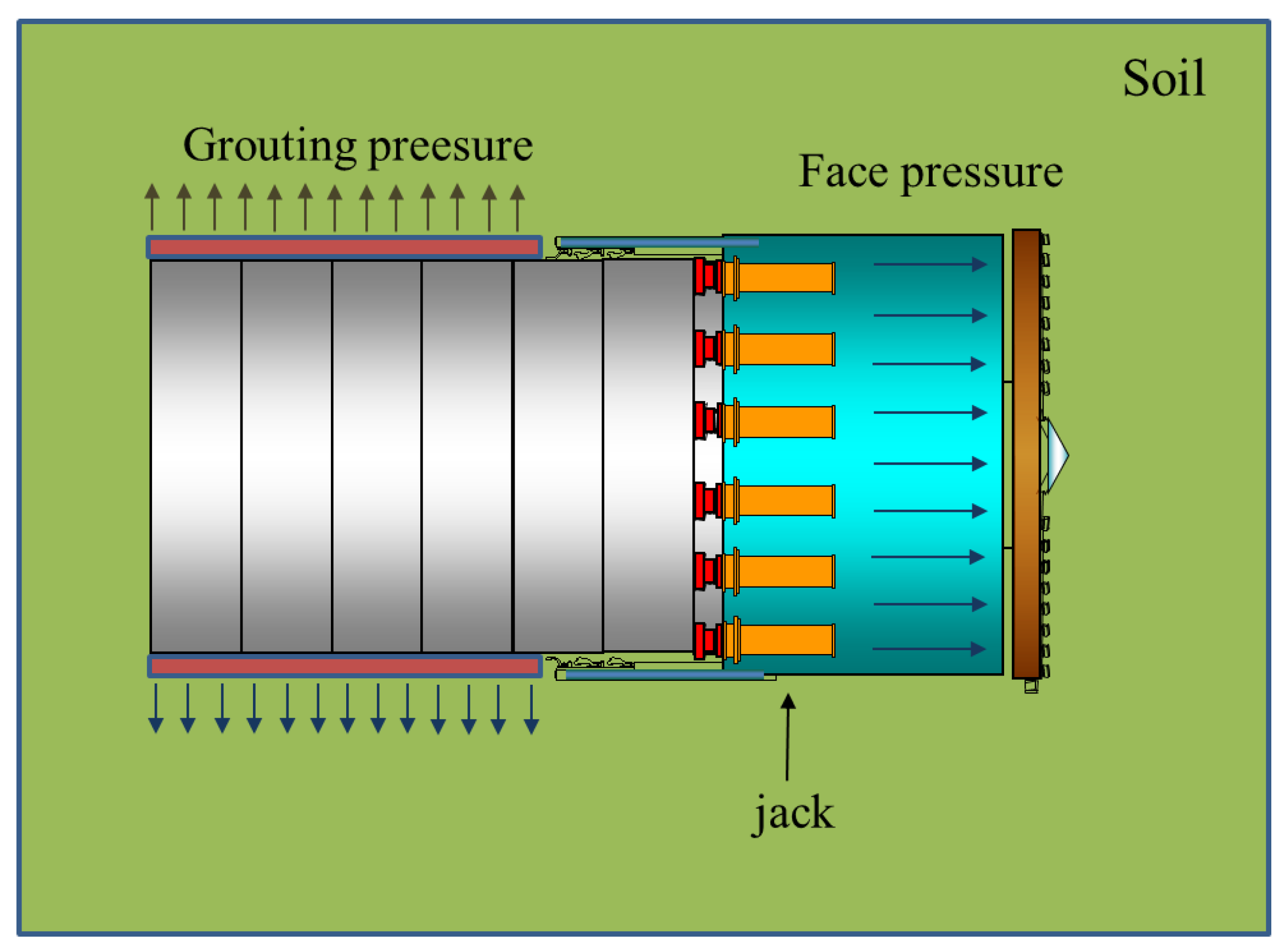

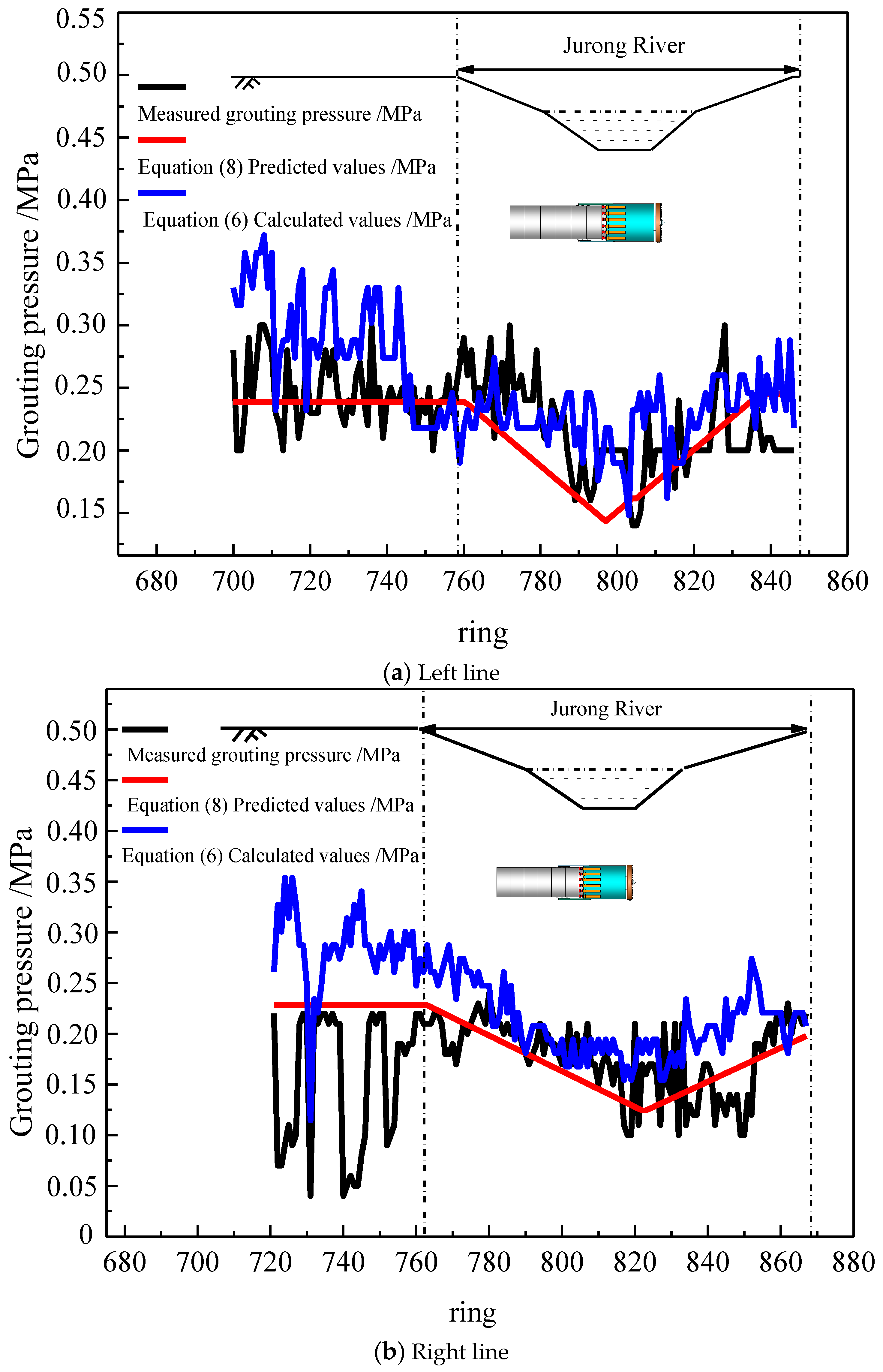
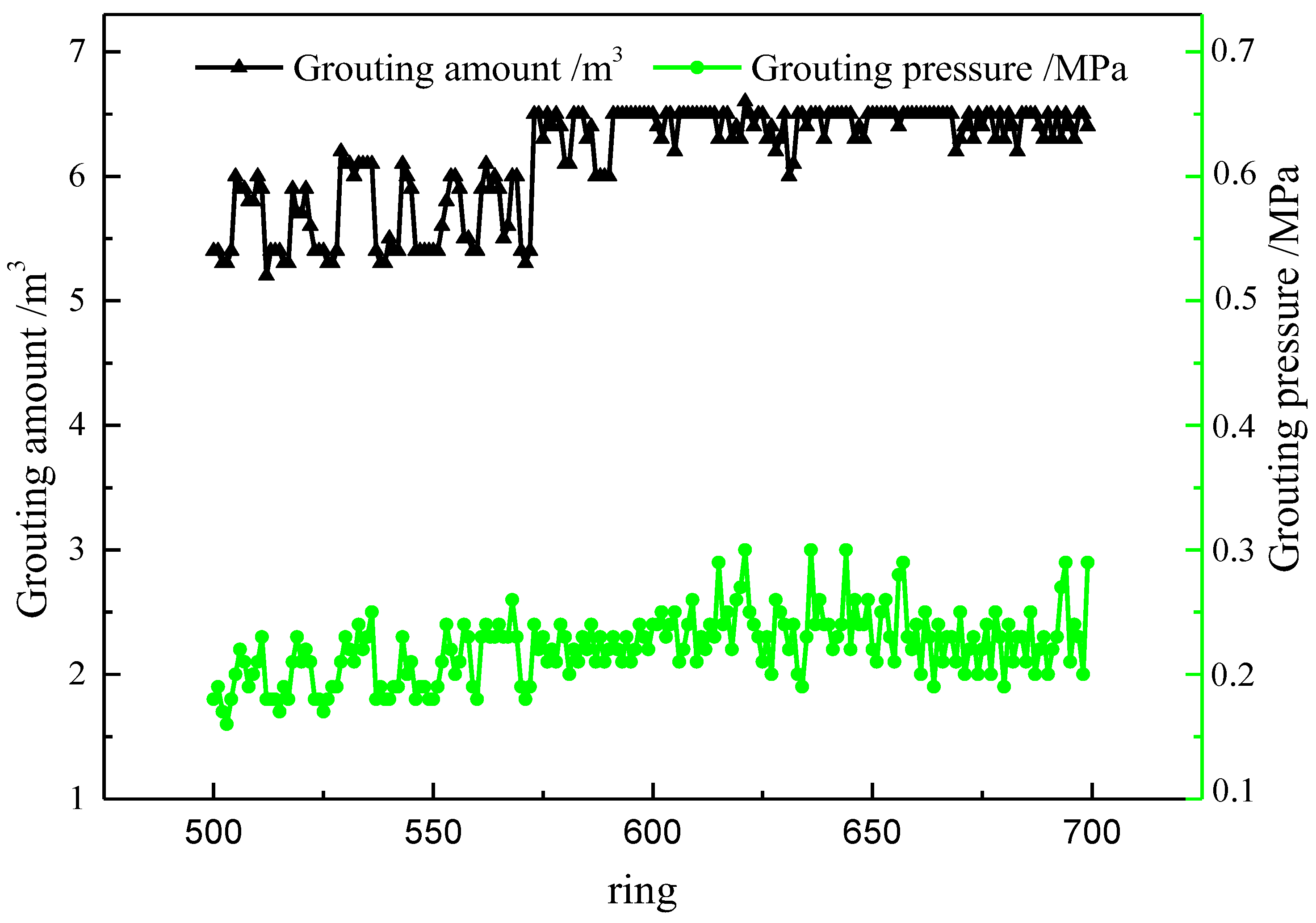
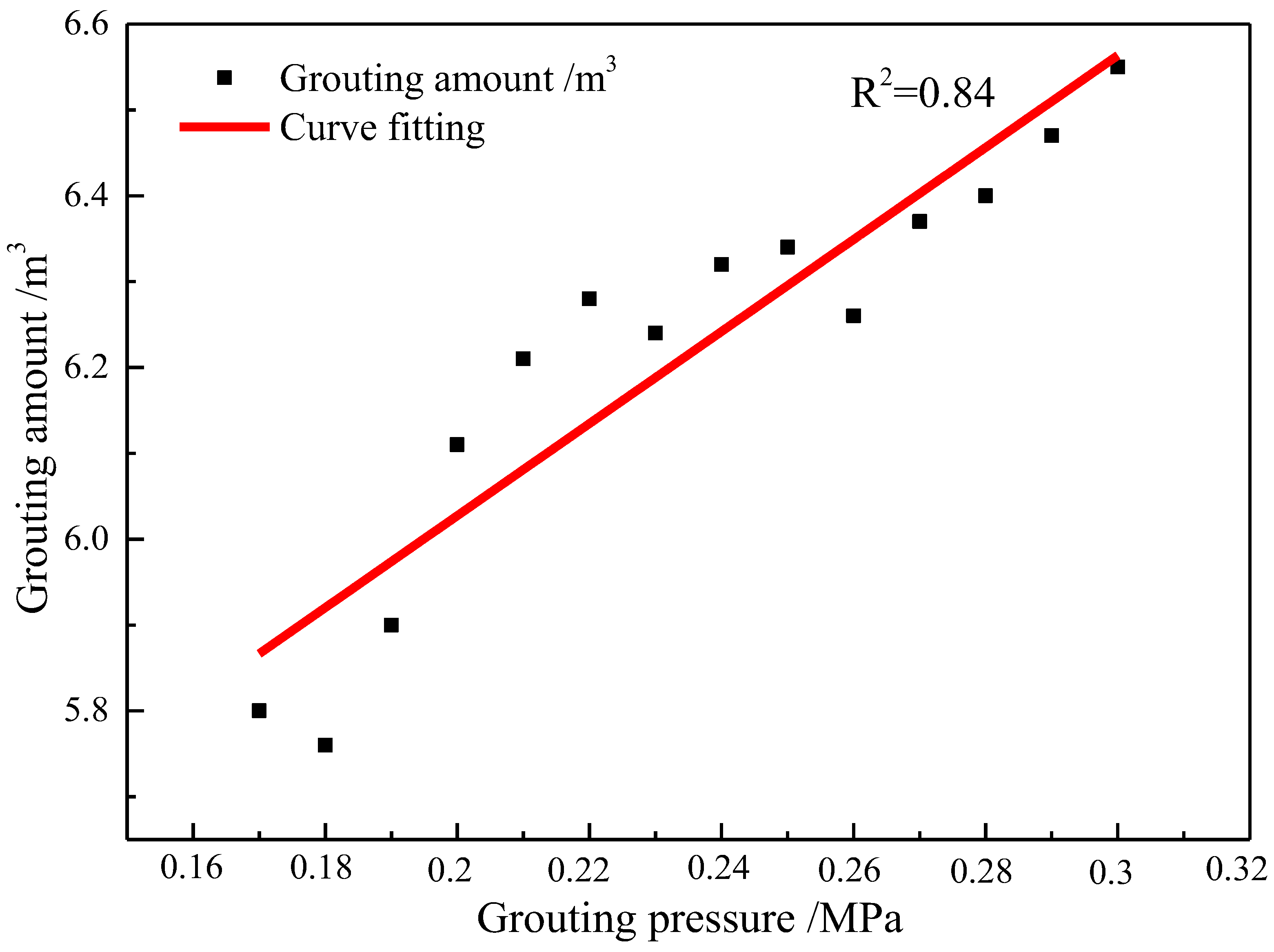

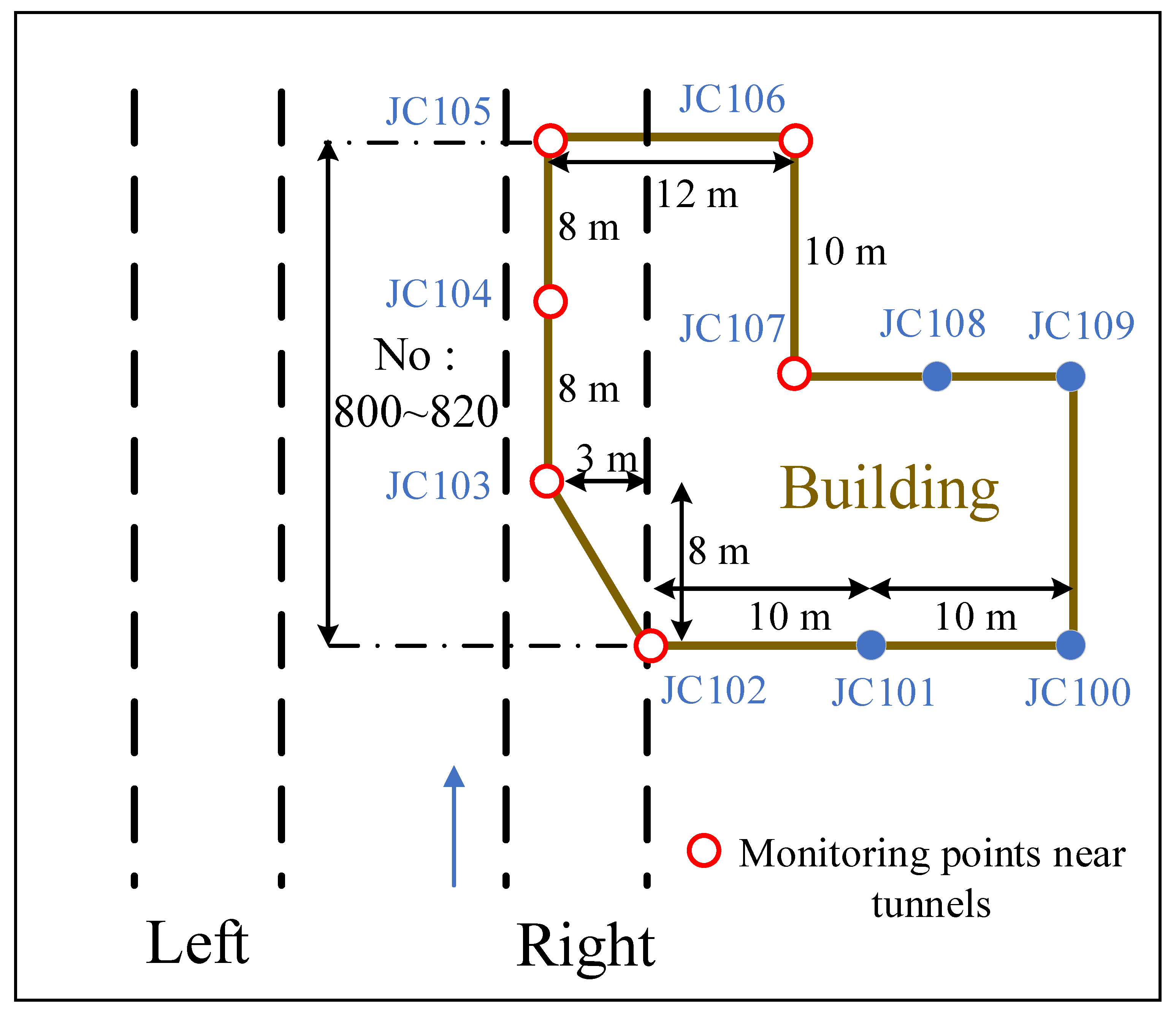
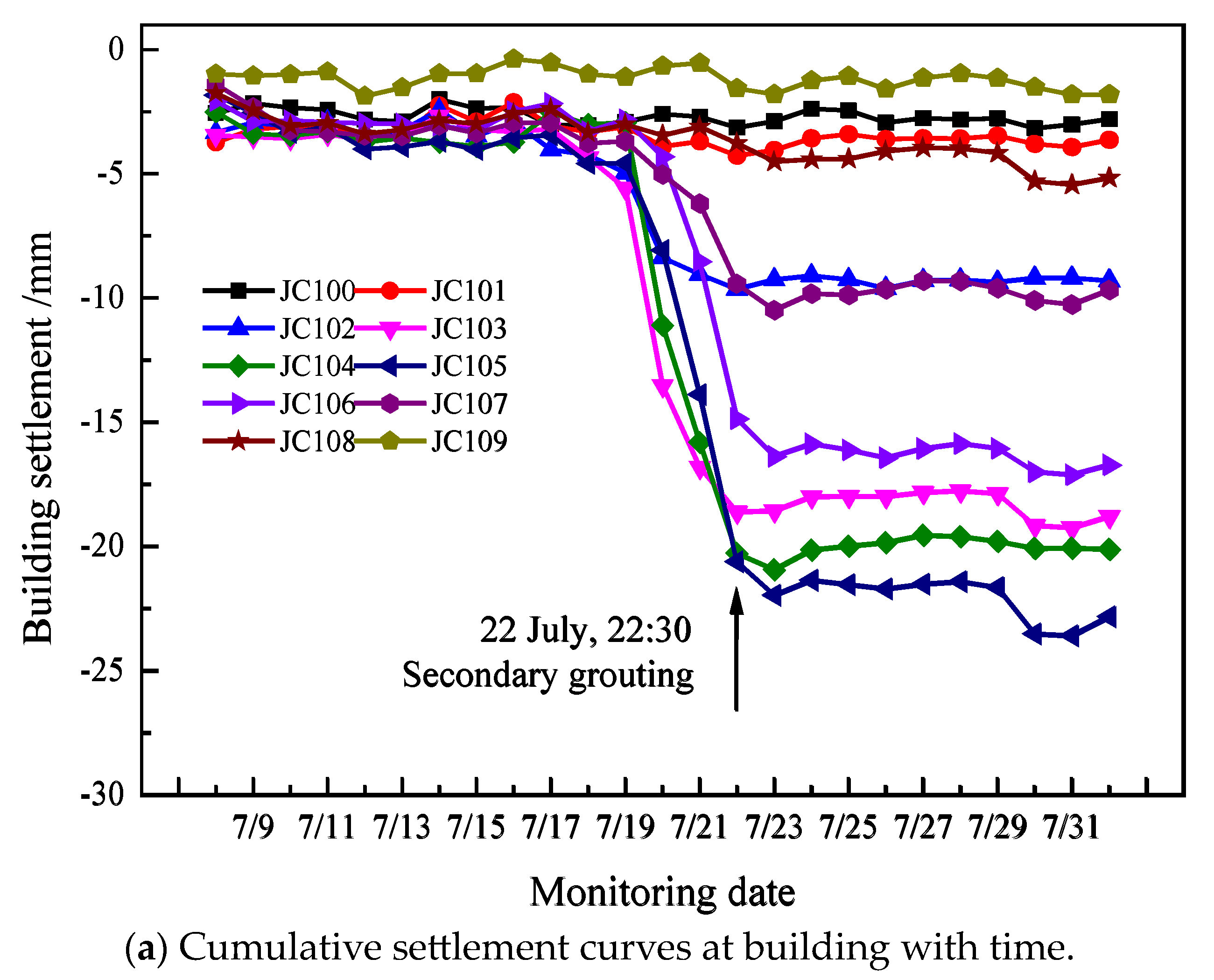
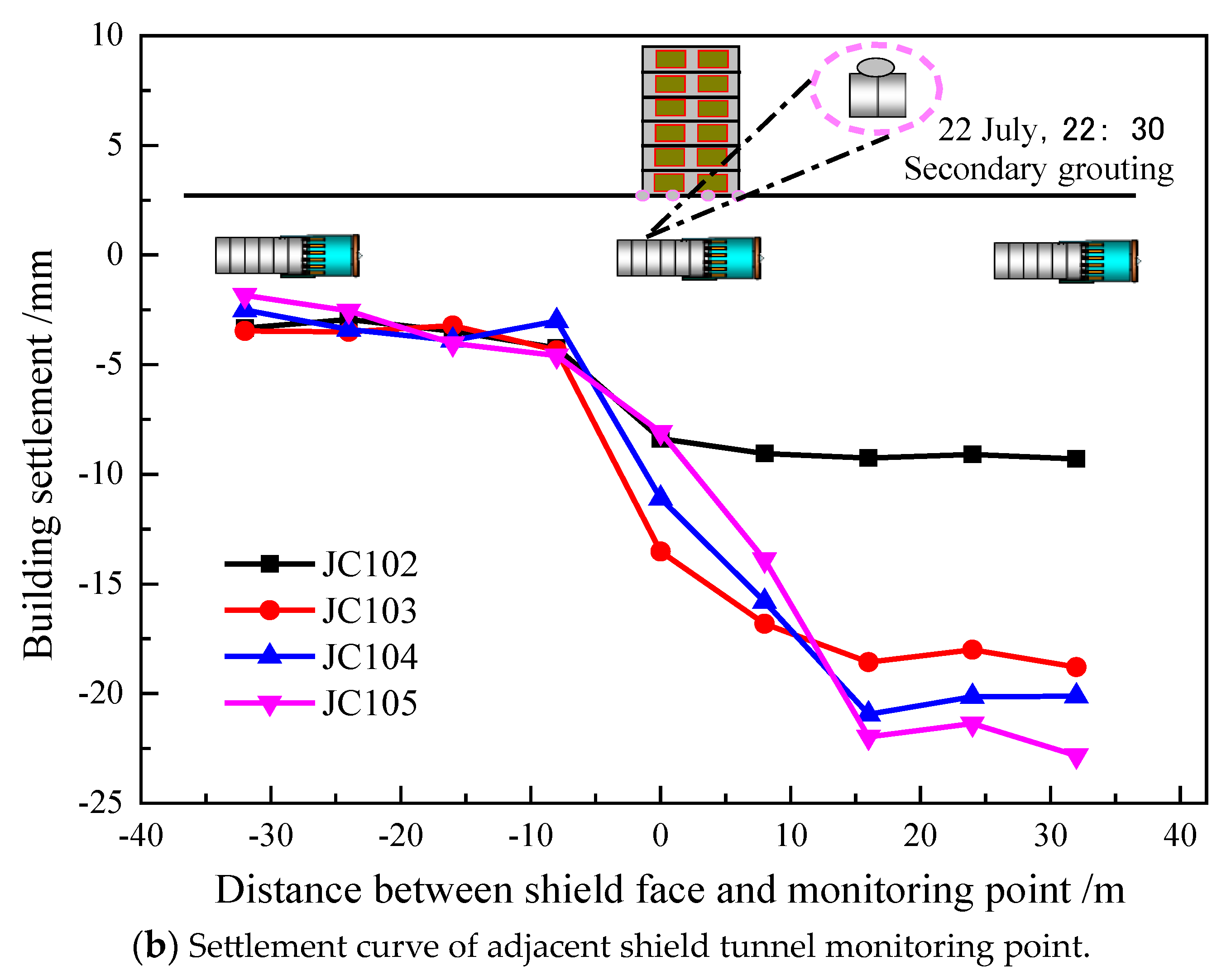
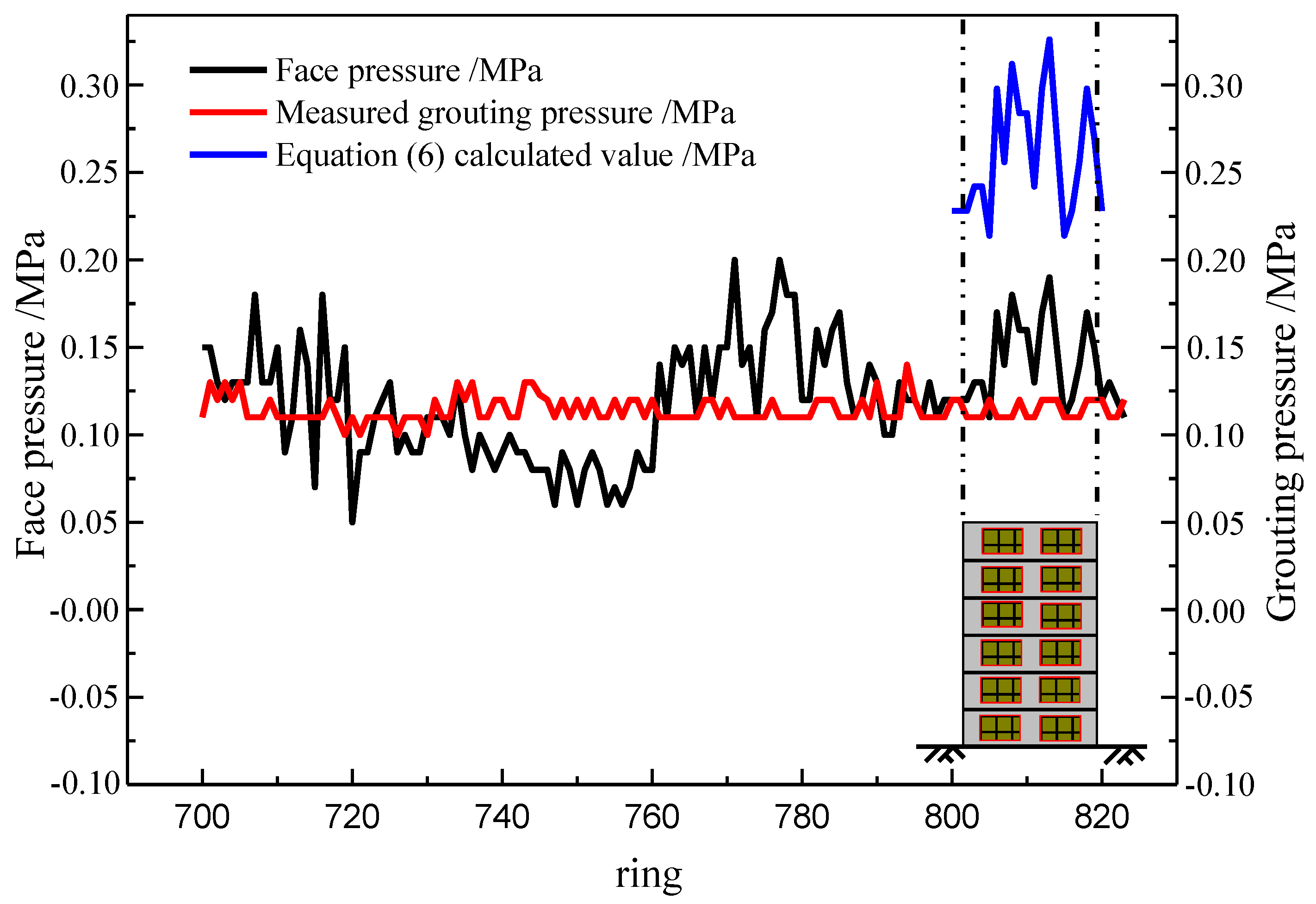
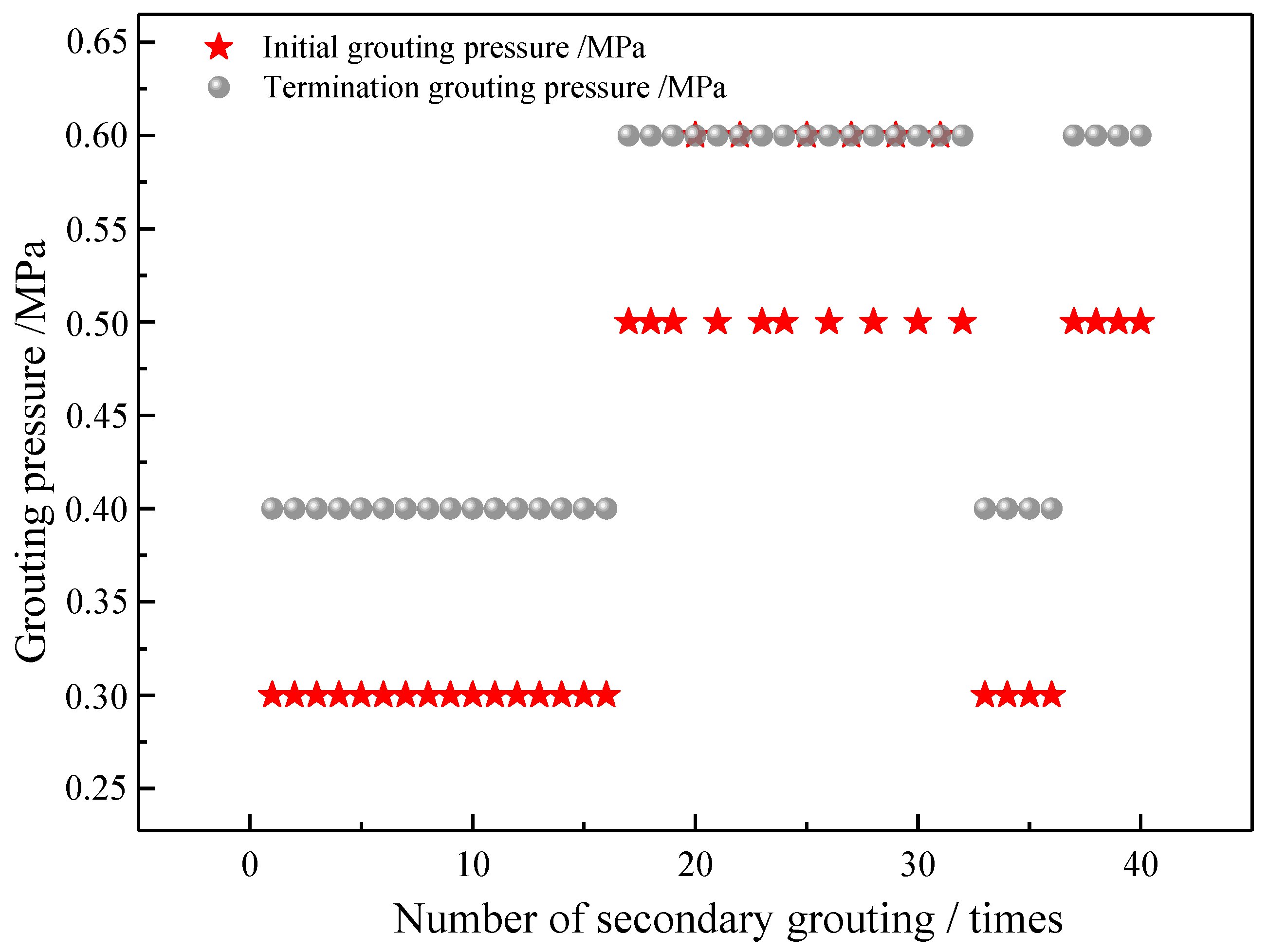
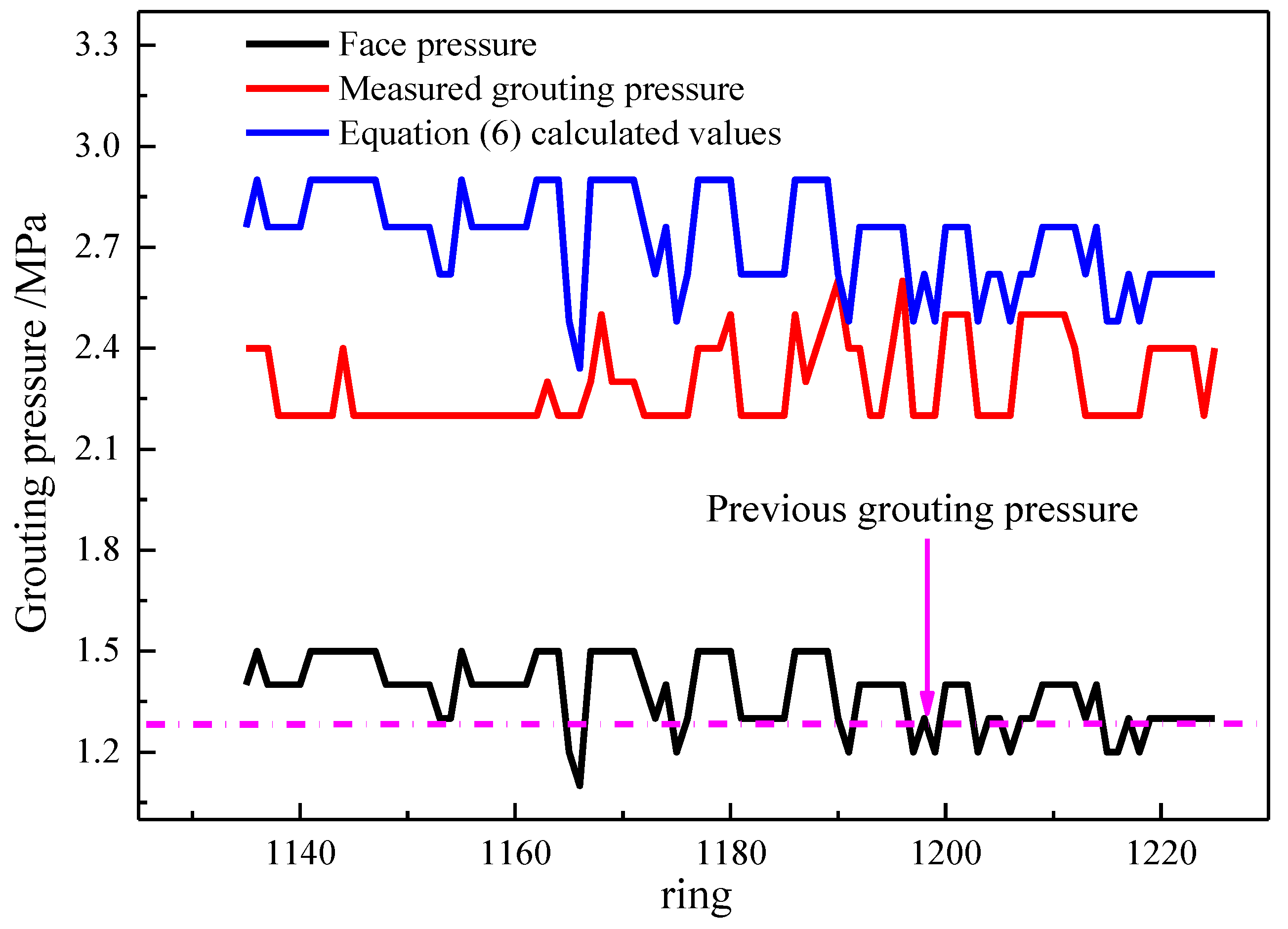
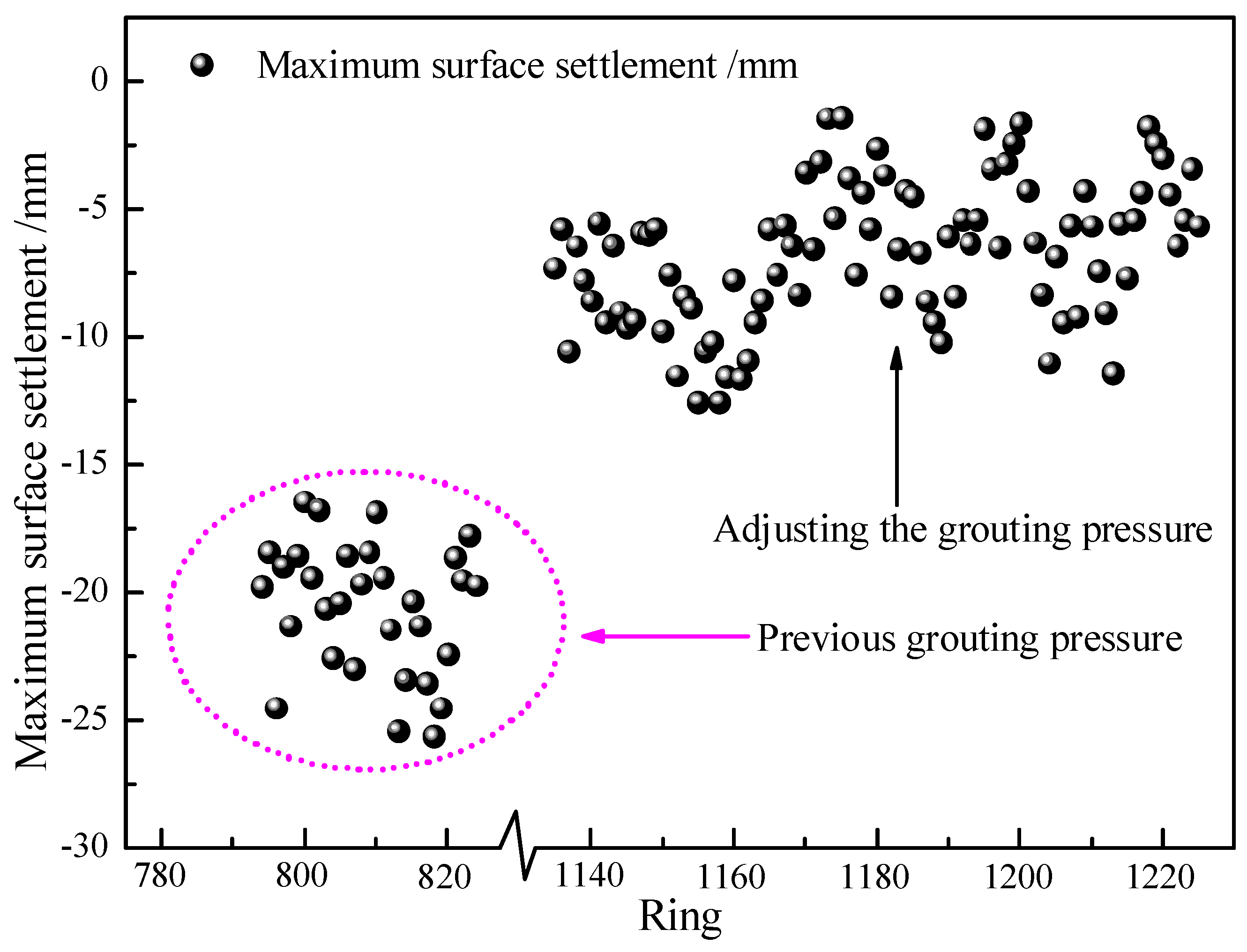

| Measured Grouting Volume/m3 | Equation (9)/m3 | Fitting Equation (10)/m3 | |
|---|---|---|---|
| Left line | 562.7 | 583.3 | 574.7 |
| Right line | 588 | 624 | 601.3 |
Disclaimer/Publisher’s Note: The statements, opinions and data contained in all publications are solely those of the individual author(s) and contributor(s) and not of MDPI and/or the editor(s). MDPI and/or the editor(s) disclaim responsibility for any injury to people or property resulting from any ideas, methods, instructions or products referred to in the content. |
© 2024 by the authors. Licensee MDPI, Basel, Switzerland. This article is an open access article distributed under the terms and conditions of the Creative Commons Attribution (CC BY) license (https://creativecommons.org/licenses/by/4.0/).
Share and Cite
Wang, M.; Zhao, C.; Yang, S.; Xu, J. Optimizing Grouting Parameters to Control Ground Deformation in the Shield Tunneling. Buildings 2024, 14, 2799. https://doi.org/10.3390/buildings14092799
Wang M, Zhao C, Yang S, Xu J. Optimizing Grouting Parameters to Control Ground Deformation in the Shield Tunneling. Buildings. 2024; 14(9):2799. https://doi.org/10.3390/buildings14092799
Chicago/Turabian StyleWang, Mei, Chenyue Zhao, Songsong Yang, and Jingmin Xu. 2024. "Optimizing Grouting Parameters to Control Ground Deformation in the Shield Tunneling" Buildings 14, no. 9: 2799. https://doi.org/10.3390/buildings14092799
APA StyleWang, M., Zhao, C., Yang, S., & Xu, J. (2024). Optimizing Grouting Parameters to Control Ground Deformation in the Shield Tunneling. Buildings, 14(9), 2799. https://doi.org/10.3390/buildings14092799






